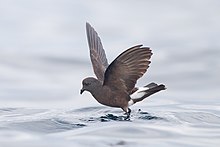Wilson's petrel
| Wilson's storm petrel | |
|---|---|
 |
|
| Scientific classification | |
| Kingdom: | Animalia |
| Phylum: | Chordata |
| Class: | Aves |
| Order: | Procellariiformes |
| Family: | Oceanitidae |
| Genus: | Oceanites |
| Species: | O. oceanicus |
| Binomial name | |
|
Oceanites oceanicus Kuhl, 1820 |
|
 |
|
| Distribution range (blue) | |
Wilson's storm petrel (Oceanites oceanicus), also known as Wilson's petrel, is a small seabird of the austral storm petrel family Oceanitidae. It is one of the most abundant bird species in the world and has a circumpolar distribution mainly in the seas of the southern hemisphere but extending northwards during the summer of the northern hemisphere. The world population has been estimated to be more than 50 million pairs. The name commemorates the Scottish-American ornithologist Alexander Wilson. The genus name Oceanites refers to the mythical Oceanids, the three thousand daughters of Tethys. The species name is from Latin oceanus, "ocean".
Originally described in the genus Procellaria it has been placed under the genus Oceanites. Two or three subspecies are recognized and one population maorianus from New Zealand may be extinct. The nominate population breeds from Cape Horn to the Kerguelen Islands while exasperatus breeds along the Antarctic coast in the South Shetland and other islands. The population from Tierra del Fuego was described as chilensis (=wollastoni, magellanicus) but this is considered a nomen nudum although some authors have reinstated it, noting that it can be distinguished by white mottling on the belly.
The name Mother Carey's chicken was used in early literature and often applied to several petrel species while the generic name of stormy petrel referred to the idea that their appearance foretold stormy weather. Some authors called it the yellow-webbed storm-petrel.
Wilson's storm petrel is a small bird, 16–18.5 cm (6.3–7.3 in) in length with a 38–42 cm (15–16.5 in) wingspan. It is slightly larger than the European storm petrel and is essentially dark brown in all plumages, except for the white rump and flanks. The feet jut beyond the square ended tail in flight. The European storm petrel has a very distinct whitish lining to the underwing and a nearly all dark upperwing. Wilson's storm petrel has a diffuse pale band along the upper wing coverts and lacks the distinctive white underwing lining. The webbing between the toes is yellow with black spots in pre-breeding age individuals.
...
Wikipedia

